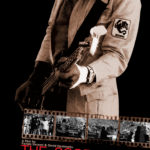Length: 50 minutes
Category: Documentary
Country: Iran
Year of production: 2001
Screened in: 2012 Festival Cinema Invisible
Synopsis
This documentary begins by an interview with Farrokh Ghaffari at his home in Paris and introduces to the audience one of the most avant-gardes filmmakers of the Iranian cinema. Watching this movie, we are invited to Farrokh Ghaffari’s home, and with him travel to the not so distant past of Iranian cinema. We watch Farrokh’s childhood. He accompanies his father traveling to to Belgium when he is only twelve years old. During his studies in Belgium and France his soul is aflame by the magic rays of cinema.
Ghaffari returns to Iran bringing with him a camera as souvenir and starts a new path, which is followed by Iranian youths to the point where we witnessed in Festival Cinema Invisible. In his interview, Farrokh Ghaffari, the actor/director, critic and writer speaks of late Ebrahim Golestan and Fereidoon Rahnama upon whose partnership he established the first National Iranian Movie Center and founded the first new wave in Iranian filmmaking in 1949. We learn that Ghaffari thinks about promotion of noble Iranian culture and tradition from the very beginning, and tries to make such movies that portray the real character of an Iranian man, his social life and his Iranian spirit. The documentary shows parts of The Story of the South of the City which reveals the problems of a small part of the Iranian society thus painting a page the country’s history book.
Farrokh’s realism in presenting bitter events caused by cultural poverty, as direct result of economic disadvantages of the lower classes, caused The Story of the South of the City to be censored by the Pahlavi regime. After few years of silence, Ghaffari dramatizes Iranian Society of the 1940s through a dark comedy entitled Shabe Ghoozi. His career as a filmmaker practically ends by the movie Zanboorak. The part of the movie that is shown in Roozegare Farrokh displays naiveté of the mass through sarcasm and satire. Insisting on preservation of the noble culture and traditional values of society, Farrokh Ghaffari writes the book: Tazieh. He claims to have been the first person who, “saved the cultural values of this noble tragic play” and complains how others have tried to credit themselves with this. The documentary captures an emotional moment when Ghaffari is unable to speak, weeping bitterly, when remembering Ahmad Shamloo, the late renowned Iranian poet. The film ends with footage of Farrokh Ghaffari being put to rest at Pere la Chaise, beside number of other Iranian artists and cultural icons such as Sadegh Hedayat and Gholam Hossein Saedi.

